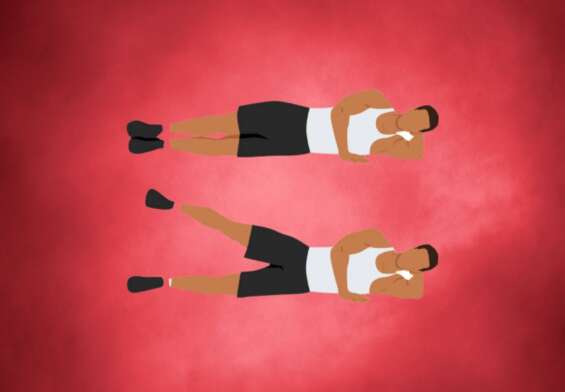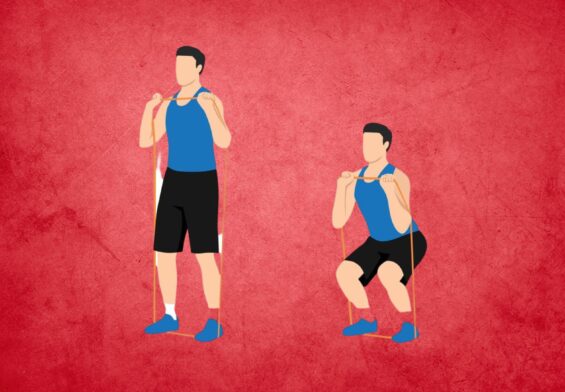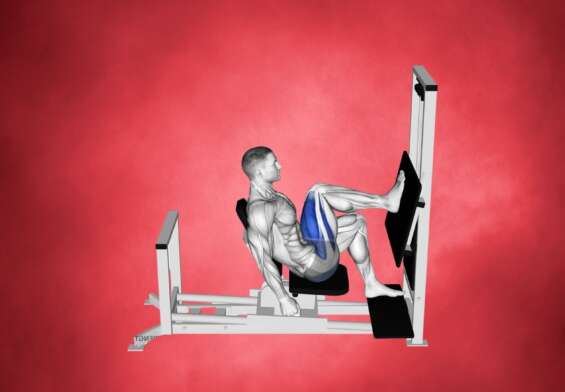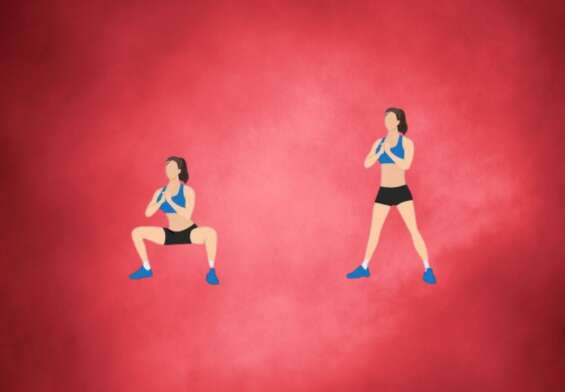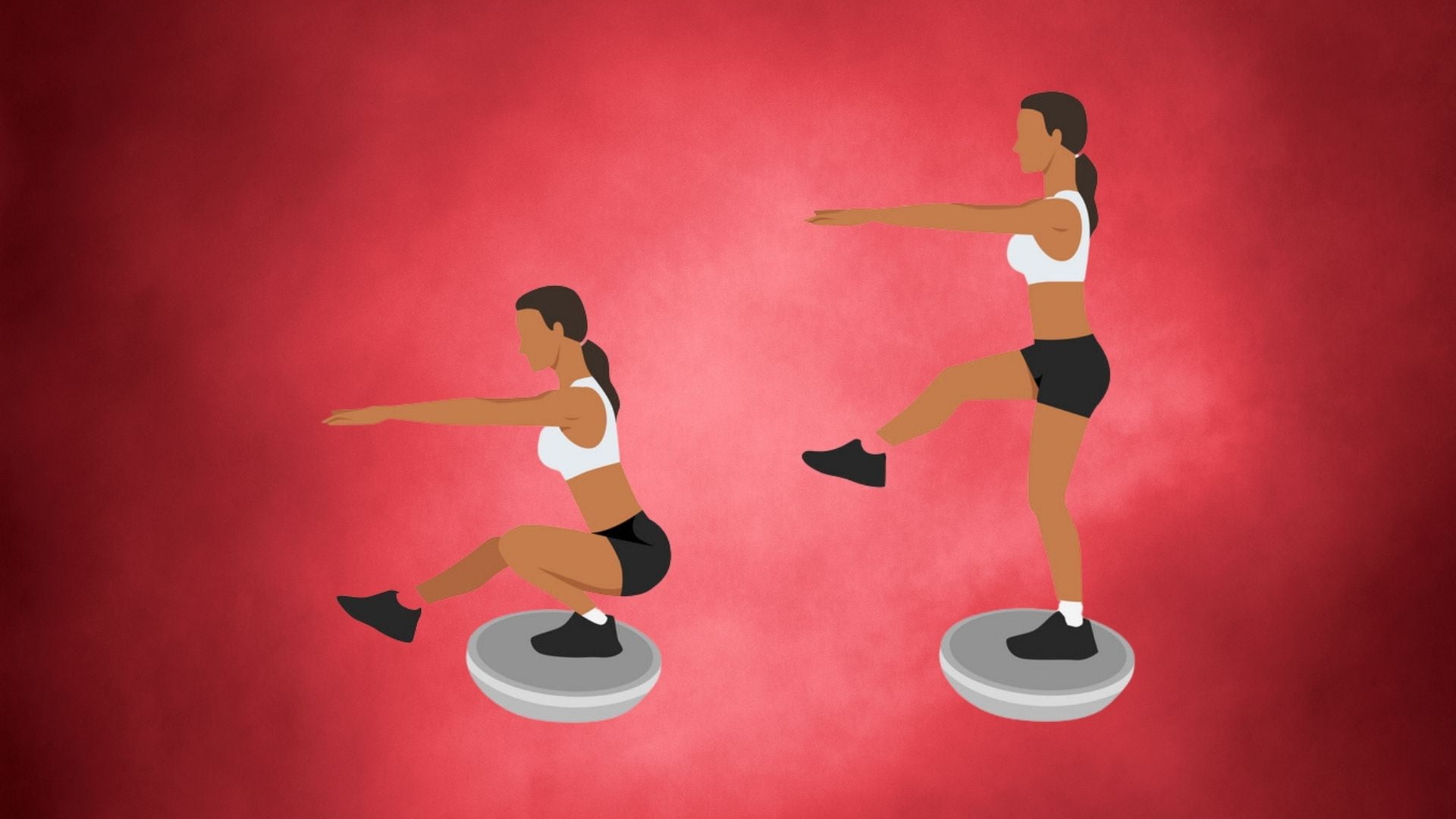
Single-Leg Skater Squat (Tone Your Legs) Full Exercise Guide
Are you looking for a challenging exercise that can help you burn calories and take your fitness to the next level? Single-leg skater squats are an excellent choice! This full-body exercise targets multiple muscle groups including your core, glutes, quads, and hamstrings. It also helps to improve your balance and coordination. Here at FitGAG, we have put together our expert guide to help you master the single-leg skater squat and reach your fitness goals. With the right technique and dedication, you’ll be able to make the most of this great exercise!
Exercise Information
The Single-Leg Skater Squat is a resistance training exercise that targets the muscles in the lower body. This exercise involves using a single-leg stance to increase balance and stability, while also increasing the intensity of the exercise. Let’s dive into some general information about this exercise:
Level
The Single-Leg Skater Squat is an intermediate-level exercise that is suitable for individuals with a basic understanding of proper form and technique.
Equipment
To perform the Single-Leg Skater Squat, you will need a resistance band.
Type of Exercise
The Single-Leg Skater Squat is a compound exercise that targets the muscles in the lower body, involving multi-joint movements that target multiple muscle groups.
Single-Leg Skater Squat: Working Muscles
The Single-Leg Skater Squat is a compound exercise that primarily targets the muscles of the lower body. This exercise involves using one leg to squat down, while keeping the other leg off the ground and extending it behind the body. In this section, we will discuss the primary and secondary muscle groups that are involved during the Single-Leg Skater Squat exercise.
Primary Muscle Group: Lower Body
The primary muscle group targeted during the Single-Leg Skater Squat exercise is the lower body, including the glutes, hamstrings, and quadriceps muscles. These muscles are responsible for controlling the squatting motion and stability of the body during the exercise.
Secondary Muscle Group: Core
In addition to the primary muscle group, the Single-Leg Skater Squat exercise also engages the muscles of the core. The abdominal muscles, obliques, and lower back are engaged to stabilize the torso and maintain proper form through the full range of motion.
By engaging both the primary and secondary muscle groups, the Single-Leg Skater Squat exercise provides a comprehensive lower body workout. This makes it an effective exercise for building leg muscle strength and size, improving balance and coordination, and developing functional fitness for activities in daily life.
Stay tuned for the next section, where we will discuss the benefits of the Single-Leg Skater Squat exercise.
Benefits of Single-Leg Skater Squat
Single-Leg Skater Squat is a great exercise for strengthening your lower body, improving balance, and enhancing your athletic performance. Here are five benefits of incorporating this exercise into your fitness routine:
- Improved Balance: Single-Leg Skater Squat helps improve your balance by forcing you to focus on stabilizing your body while performing the exercise and engaging your core muscles.
- Increased Range of Motion: Single-Leg Skater Squat allows you to work your lower body through a full range of motion, which can help improve your overall lower body flexibility.
- Enhanced Muscle Recruitment: Single-Leg Skater Squat engages more muscles in your lower body, which can help improve overall functional strength and movement patterns.
- Improved Athletic Performance: Single-Leg Skater Squat can help improve your overall athletic performance by increasing your lower body power and balance.
- Variation and Progression: Single-Leg Skater Squat can add variation to your lower body workouts, which can help prevent boredom and stimulate new muscle growth. Additionally, the exercise can be made more challenging by increasing the height of the object you are hopping over or the number of reps.
By incorporating Single-Leg Skater Squat into your fitness routine, you can enjoy these benefits and more. However, it’s important to start slowly and progress gradually to avoid injury and ensure proper form. Additionally, it’s important to incorporate a variety of exercises into your fitness routine to ensure you’re targeting all muscle groups and avoiding boredom.
Single-Leg Skater Squat: Step-by-Step Instructions
The single-leg skater squat is a great exercise for strengthening the muscles of your lower body, especially your glutes and quads. Here are the step-by-step instructions for performing the single-leg skater squat:
Starting Position:
- Stand on one foot with your arms outstretched in front of you for balance.
- Position your other leg slightly behind you.
- Keep your chest up and your back straight.
Now, let’s move on to the step-by-step instructions for the single-leg skater squat:
- Bend your knee and lower your body until your supporting leg is parallel to the floor.
- Make sure to keep your chest up and your back straight throughout the movement.
- Pause briefly at the bottom of the movement.
- Push through your heel to return to the starting position.
Repeat the movement for the desired number of repetitions, then switch legs.
Single-Leg Skater Squat – Proper Form and Technique
The Single-Leg Skater Squat is an effective exercise that targets the muscles in the lower body. This exercise is performed using your own bodyweight and proper form and technique are important to avoid injury and achieve maximum results.
Starting Position
- Stand with your feet shoulder-width apart and your arms extended out in front of you.
- Lift one foot off the ground and balance on the other.
- Engage your core muscles and maintain a stable base.
Proper Form and Technique
- Squat: Bend your standing leg and lower your body into a squat, keeping your arms out in front for balance.
- Keep Your Core Engaged: Engage your core muscles and keep your chest up throughout the exercise.
- Return to the Starting Position: Return to the starting position by pushing through your standing leg to stand back up.
- Breathe Deeply: Breathe deeply and regularly throughout the exercise to maintain your energy and focus.
- Gradually Increase Intensity: Gradually increase the number of repetitions or sets of the exercise over time as your lower body muscles become stronger.
- Incorporate into Your Routine: The Single-Leg Skater Squat can be a great addition to your lower body training routine, helping you to build strength and muscle effectively.
By following these tips, you can perform the Single-Leg Skater Squat with proper form and technique, building and strengthening your lower body muscles effectively while minimizing the risk of injury. Remember to start slowly, focus on your breathing, and gradually increase the difficulty and intensity of the exercise over time.
Frequency and Progression: How to Get the Most Out of Your Single-Leg Skater Squat Workouts
The Single-Leg Skater Squat is a dynamic exercise that engages multiple muscles of the lower body, including the glutes, quads, hamstrings, and calves. In this section, we will discuss how to properly incorporate the Single-Leg Skater Squat into your workout routine and how to progress with this exercise over time.
Frequency
To see significant results with the Single-Leg Skater Squat, it is recommended to perform this exercise 2-3 times a week. However, it is important to listen to your body and avoid overtraining. If you feel any pain or discomfort, stop the exercise immediately. You can also alternate between the Single-Leg Skater Squat and other lower body exercises, such as goblet squats or Bulgarian split squats.
Progressive Overload
To progress with the Single-Leg Skater Squat, it is important to gradually increase the difficulty of the exercise over time. Start with a lighter weight and gradually increase the weight as you become stronger. Another way to progress is to decrease the rest time between sets or increase the number of repetitions. Gradually increase the weight and reps/sets and avoid adding too much too quickly.
Mix It Up
To prevent boredom and keep your Single-Leg Skater Squat workouts fresh, it is important to mix up your exercise routine. You can perform the Single-Leg Skater Squat with different weights and reps or vary the tempo of the movement. You can also incorporate other lower body exercises, such as walking lunges or single-leg hip thrusts.
Proper Form
Proper form is essential when performing the Single-Leg Skater Squat to avoid injury and get the most out of the exercise. Start by standing on one leg with your feet slightly wider than shoulder-width apart. Bend your knee and lower your body into a squat, keeping your chest up and your back straight. As you lower your body, swing your arms forward and back. Drive through your heel as you return to the starting position. Switch legs and repeat.
Track Your Progress
To ensure you are making progress and staying on track with your Single-Leg Skater Squat workouts, it is important to track your progress. Keep a workout journal or use a fitness app to log the weight, reps, and sets for each exercise. This will help you identify areas where you need to improve and keep you motivated to continue pushing yourself.
Incorporating the Single-Leg Skater Squat into your lower body workout routine can be a great way to build strength, improve balance, and increase power. By following these tips for frequency, progressive overload, and proper form, you can ensure that you are getting the most out of your Single-Leg Skater Squat workouts and reaching your fitness goals.
Mistakes of Single-Leg Skater Squat Exercise
The single-leg skater squat exercise is a great way to build strength and stability in the lower body. However, like any exercise, there are common mistakes that can reduce its effectiveness and increase the risk of injury. Here are five mistakes to avoid during the single-leg skater squat exercise:
- Not using proper form: Using poor form during the single-leg skater squat exercise can reduce its effectiveness and increase the risk of injury. It’s essential to maintain proper alignment of the hips, knees, and ankles throughout the exercise.
- Not using a full range of motion: Neglecting to use a full range of motion during the single-leg skater squat exercise can reduce its effectiveness. Make sure to fully extend your leg before returning to the starting position.
- Not engaging the core muscles: Engaging the core muscles is essential to ensure that you are targeting the correct muscles during the single-leg skater squat exercise. Failure to engage these muscles can reduce the effectiveness of the exercise.
- Not using proper breathing: Using improper breathing technique during the single-leg skater squat exercise can reduce its effectiveness and increase the risk of injury. Make sure to exhale as you lower your body and inhale as you return to the starting position.
- Not maintaining balance: Maintaining balance is essential to ensure that you are performing the exercise correctly. Failing to do so can reduce its effectiveness and increase the risk of injury.
By avoiding these common mistakes, you can ensure that you are getting the most out of your single-leg skater squat exercise while reducing the risk of injury. Remember to use proper form, use a full range of motion, engage the core muscles, use proper breathing, and maintain balance throughout the exercise. With consistent practice, you can improve your lower body strength and stability with the single-leg skater squat exercise.
Variations of Single-Leg Skater Squat: Add Challenge to Your Lower Body Training
Single-Leg Skater Squat is a great exercise to help target and strengthen your lower body muscles. However, doing the same exercise every day can become monotonous over time. Here are some variations to add challenge and variety to your training routine and challenge your lower body muscles in different ways:
Single-Leg Skater Squat with Resistance Bands
This variation involves using resistance bands to add extra resistance and challenge your lower body muscles. Be sure to use proper form and technique and avoid jerking or pulling the bands.
Single-Leg Skater Squat with Pause
This variation involves pausing for a few seconds at the end of each repetition, which challenges your lower body muscles and improves your overall muscular endurance. Be sure to keep your core engaged and your back straight throughout the exercise.
Single-Leg Skater Squat with Isometric Hold
This variation involves holding the fully contracted position of the exercise for a few seconds, which challenges your lower body muscles and improves your overall muscular endurance. Be sure to keep your core engaged and your back straight throughout the exercise.
Single-Leg Skater Squat with Calf Raise
This variation involves adding a calf raise to the exercise, which targets your lower body muscles and improves your overall lower body strength and stability.
Incorporating these variations into your Single-Leg Skater Squat routine can help you add challenge and variety to your lower body training and achieve greater gains in overall lower body strength and athletic performance. As always, make sure to use proper form and technique to avoid injury.
Single-Leg Skater Squat: 5 Alternatives to Increase Leg Strength
The single-leg skater squat is a great exercise for increasing leg strength and building balance. However, if you’re looking to mix up your routine or add some variety, there are plenty of alternatives you can try. In this section, we’ll explore five exercises that target your lower body and can help you build strength and improve your balance.
Lunges
Lunges are a great exercise for targeting your lower body and building strength.
- Stand with your feet shoulder-width apart and take a large step forward with one leg.
- Lower your body until both knees are bent at 90 degrees.
- Push back up to the starting position and repeat for the desired number of repetitions before switching sides.
Step-Ups
Step-ups are a great exercise for targeting your lower body and improving your balance.
- Stand in front of a step or bench and place one foot on it.
- Push up through your heel and raise your body up until your leg is straight.
- Lower your body back down to the starting position and repeat for the desired number of repetitions before switching sides.
Squat Jumps
Squat jumps are a great exercise for targeting your lower body and building strength.
- Stand with your feet shoulder-width apart and lower your body into a squat.
- Explode up and jump as high as you can.
- Land back in the squat position and repeat for the desired number of repetitions.
Reverse Lunges
Reverse lunges are a great exercise for targeting your lower body and improving your balance.
- Stand with your feet shoulder-width apart and take a large step backward with one leg.
- Lower your body until both knees are bent at 90 degrees.
- Push back up to the starting position and repeat for the desired number of repetitions before switching sides.
Single-Leg Deadlifts
Single-leg deadlifts are a great exercise for targeting your lower body and building strength.
- Stand with your feet shoulder-width apart and hold a weight in one hand.
- Lower your body and extend your opposite leg behind you.
- Push back up to the starting position and repeat for the desired number of repetitions before switching sides.
Incorporating these alternatives to single-leg skater squat exercises into your routine is a great way to increase your leg strength and improve your balance. These exercises require little to no equipment and can be done at home or at the gym. Give them a try and see how they work for you!
Single-Leg Skater Squat: Tips and Tricks for Building Stronger Glutes and Legs
The Single-Leg Skater Squat is a great exercise for targeting your glutes and leg muscles. In this section, we’ll share some tips and tricks to help you perform the Single-Leg Skater Squat correctly and get the most out of it.
- Warm-Up: Before performing the Single-Leg Skater Squat, it’s important to warm up your entire lower body. You can do this by performing some light cardio or dynamic stretching, such as leg swings.
- Use the Right Equipment: To perform the Single-Leg Skater Squat, you need a resistance band. Make sure you choose the right resistance level for your needs and follow the manufacturer’s instructions for use.
- Proper Form: Maintaining proper form is crucial when performing the Single-Leg Skater Squat. Begin by standing with your feet hip-width apart and your arms extended in front of you. Bend your right knee and lower yourself into a half-squat, then extend your right leg out to the side and lower your left knee to the ground. Push off the ground with your left leg and return to the starting position.
- Engage Your Glutes and Legs: To perform the Single-Leg Skater Squat correctly, you need to engage your glutes and leg muscles. Focus on squeezing your glutes and quads as you lower yourself into the squat.
- Use the Right Repetition Range: Aim to perform 2-3 sets of 8-12 reps with the Single-Leg Skater Squat.
- Mix it Up: Mixing up your Single-Leg Skater Squat routine can help keep your workout fresh and challenging. You can try different variations, such as changing the resistance level or using a different starting position.
- Stretch Afterwards: After performing the Single-Leg Skater Squat, it’s important to stretch your entire lower body, especially your glutes and legs.
- Listen to Your Body: As with any exercise, it’s important to listen to your body and avoid pushing beyond your limits. If you feel any discomfort or pain, stop the exercise immediately.
Incorporating these tips and tricks into your Single-Leg Skater Squat routine can help you get the most out of this exercise and achieve stronger glutes and leg muscles. Remember to always maintain proper form, engage your glutes and leg muscles, and listen to your body. With time and practice, you’ll be able to perform the Single-Leg Skater Squat like a pro and enjoy the benefits of stronger and more toned glutes and legs.
Incorporating Single-Leg Skater Squats into Your Workout Routine for Maximum Effect
Single-leg skater squats are a great exercise for improving your balance, strengthening your lower body, and increasing your overall power. Here are some tips to help you incorporate this exercise into your workout routine for maximum effect:
- Warm-up properly: Before doing single-leg skater squats, it’s important to warm up your lower body with exercises like bodyweight squats, lunges, and calf raises.
- Use proper form: To perform single-leg skater squats, stand on one leg with your feet slightly wider than shoulder-width apart and your toes pointing out. Bend your standing leg to lower your body towards the ground, making sure to keep your back straight and your chest up. Push off with your standing leg to return to the starting position and repeat.
- Mix up your routine: Don’t just perform single-leg skater squats in isolation. Mix it up by incorporating other exercises that target your lower body, such as squats, deadlifts, and lateral lunges.
- Use progressive overload: To continue to see progress, you’ll need to use progressive overload, which means gradually increasing the resistance or repetitions over time.
- Don’t overdo it: It’s important to give your muscles time to recover, so don’t overdo it with single-leg skater squats. Aim to perform the exercise for 2-3 sets, 1-2 times per week.
- Focus on your breathing: It’s important to regulate your breathing throughout the exercise to ensure that you’re getting enough oxygen to your muscles. Inhale as you lower your body towards the ground and exhale as you return to the starting position.
- Engage your core: To get the most out of single-leg skater squats, make sure to engage your core muscles, including your abs, hips, and lower back. This will help you maintain proper form and prevent injury.
- Rest between sets: Allow your muscles time to recover between sets. Rest for 60-90 seconds between sets to ensure that you’re performing each rep with proper form.
- Incorporate single-leg skater squats into your workout routine: In addition to incorporating single-leg skater squats into your workout routine, consider doing them as part of a superset or a circuit to challenge your muscles even more.
By incorporating these tips into your workout routine, you’ll be well on your way to maximizing the benefits of single-leg skater squats and achieving better balance, a stronger lower body, and increased power.
Ultimate Workout Plan for Single-Leg Skater Squat
Single-Leg Skater Squat is an effective exercise for strengthening your lower body and improving your balance and coordination. Here’s a one-week workout plan to help you incorporate Single-Leg Skater Squat into your routine:
Day 1: Lower Body
- Warm-up: 5-10 minutes of cardio
- Single-Leg Skater Squat: 3 sets x 12-15 reps each side
- Lunges: 3 sets x 10 reps each side
- Step-Ups: 3 sets x 10 reps each side
- Calf Raises: 3 sets x 15 reps
- Cool-down: 5-10 minutes of stretching
Day 2: Rest Day
Day 3: Total Body
- Warm-up: 5-10 minutes of cardio
- Single-Leg Skater Squat: 3 sets x 12-15 reps each side
- Push-Ups: 3 sets x 10 reps
- Plank: 3 sets x 30 seconds each side
- Chin-Ups: 3 sets x 10 reps (attempt unassisted)
- Cool-down: 5-10 minutes of stretching
Day 4: Rest Day
Day 5: Lower Body
- Warm-up: 5-10 minutes of cardio
- Single-Leg Skater Squat: 3 sets x 12-15 reps each side
- Romanian Deadlift: 3 sets x 12 reps
- Glute Bridge: 3 sets x 10 reps
- Hip Thrusters: 3 sets x 10 reps
- Cool-down: 5-10 minutes of stretching
Day 6: Rest Day
Day 7: Lower Body
- Warm-up: 5-10 minutes of cardio
- Single-Leg Skater Squat: 3 sets x 12-15 reps each side
- Squats: 3 sets x 10 reps
- Leg Press: 3 sets x 10 reps
- Lateral Lunges: 3 sets x 10 reps each side
- Cool-down: 5-10 minutes of stretching
Remember to maintain proper form and technique when performing Single-Leg Skater Squat. Keep your movements slow and controlled, and focus on engaging your core muscles throughout the exercise. With consistent practice and effort, you’ll be able to build a stronger and more stable lower body with Single-Leg Skater Squat.
Conclusion
Single-Leg Skater Squat is an amazing exercise for anyone looking to build strength, improve balance, and stabilize their core. To get the most out of this exercise, it’s important to maintain a good form and keep your back straight throughout the movement. Additionally, start with lighter weights and gradually increase the intensity as you progress. With proper form and the right amount of intensity, you will soon see the results of this exercise in no time. So, if you’re ready to take your lower body workout to the next level, give Single-Leg Skater Squat a try with our expert guide. Thanks for reading, and keep fit with FitGAG!






